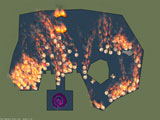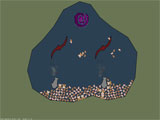I Know Rag Fu: Ragdoll Matrix Reloaded
Ragdoll Matrix Reloaded is the sequel to Ragdoll Matrix, both by R-Tsa Games. The premise of both games is the same: You control a ragdoll character, trying to dodge bullets and bombs. In Ragdoll Matrix Reloaded, they applied the obvious theme of the Agent Smith character from the Matrix movies. It fits well.
Controls
The controls in Ragdoll Matrix are keyboard-driven. The arrow keys move you around, lead by your head. You have the ability to defy gravity, too, although only in limited amounts. The green meter represents how much anti-gravity juice you have left. It recharges pretty quickly, almost to the point where you could constantly hover.
The ragdoll character feels very sluggish. I suppose this adds to the difficulty of the game, but at times I’d wish things could be a little snappier. Compare the movements the agent character in Ragdoll Matrix Reloaded to the more fluid and responsive movements of the figures in Ragdoll Masters (which was inspired by the first Ragdoll Matrix game, by the way). Tuning a physics system to feel responsive is certainly no easy task, but I get the sense that the folks at R-Tsa didn’t do much at all in this department. It shows.
There are a set of advanced controls in Ragdoll Matrix Reloaded: the ability to go stiff, control your entire body, and stick your legs and arms to the ceiling. Unfortunately, you need to unlock these by abilities by playing through the game on various difficulty modes and settings. The little I was able to unlock was hard to control and not very intuitive.
Difficulty Progression
The goal of the game is to dodge bullets. At regular interviews, a handful of bullets come firing in from random positions on the screen. They always aim at you, so a good rule of thumb is to keep moving around the screen. The game has a very nice cinematic feel when events line up properly; bending over backwards to just barely dodge a bullet is a lot of fun.
On the harder levels, the bullets move faster, do more damage, and the game introduces bombs. Bombs bounce around and then explode, which in practice simply transform a section of the screen into a no-go zone.
Play Modes
Ragdoll Matrix Reloaded has a very neat asymmetrical same-computer two-player game mode. One player controls the Agent Smith character, as usual, but the other player moves the mouse cursor and gets to control the shots. They’re given a number of shots to fire at once, and get to click anywhere on screen to fire there. It’s much more interesting compared to the single-player mode, where the shots are always aimed directly at you.
There’s a proper networked multiplayer mode, too, although I wasn’t able to try it out.
Technology
Ragdoll Matrix Reloaded was created with Game Maker. Physics are handled by ODE via the GM_ODE bindings. It’s great to see physics games being produced by the game-development-for-everyone style middleware and packages.


(Ragdoll Matrix Reloaded Game Screenshots)
Dodge This!
While Ragdoll Matrix Reloaded probably won’t hook you to the point of playing every day for hours at a time, it’s certainly a fun distraction. As physics games go it’s worth checking out. And, it’s freeware. You don’t have a reason not to play!
Download Ragdoll Matrix Reloaded game here (17.7 MB), the music-less version here (3.0 MB), or head on over to the R-Tsa Games homepage for more information.
Related Posts:
- List of Physics Games
- Nimble Ninjas Face Ferocious Foes
- Interview: Matteo Guarnieri, Rag Doll Software
- Walaber Experiments with Ragdolls and Aerial Skiing
- Physics-Based Beatdowns, Ragdoll Masters
Game Developer’s Conference 2006
Hey everyone! Anyone keeping careful count probably noticed the site drop from three updates per week to two. Fear not, it will go back to three/week soon–the reduced activity has been due to preparation for this year’s Game Developer’s Conference. I’ll try to update next week during the actual show, but more than likely I’ll be completely swamped with other activities.
Feel free to stop by and say hello if you’ll be attending the GDC this year. One of our company’s casual games, Glow Worm, is nominated in the Independent Games Festival for art and audio this year. You can find me at our booth in the IGF pavilion when I’m not in a meeting.
Cricetinae Almighty: Stunt Hamsters
Stunt Hamsters was a product of the third Indie Game Jam, which placed 21 game developers in one room for four days to hammer out a bunch of experimental games. Each Indie Game Jam has been themed, and the theme of IGJ2 was “Physics in Gameplay”, or, more explicitly, “Physics must be good for something besides ragdolls and exploding crates!”
How to Play
The game’s readme.txt file describes the action as follows:
In this game, you will see cute, furry, ignitable hamsters fire out of cannons at fixed rates until the total number of hamsters for a level have been fired. You can click and drag the mouse on a cannon or other world object to spin it around. You can click and drag elsewhere, on hamsters, to suck them up and re-fire them out of the cannon. The goal is to get the required number of hamsters into the spinning purple vortex goal. On the simplest level, you just point the cannon at the goal. In the later levels, the task becomes more complicated.
You simply click on hamsters to remove them from the level. You’ll want to do this when the maximum concurrent number of hamsters is reached. There is no limit to how many total hamsters will spawn, and no time limit. The levels are more like puzzles; you need to figure out exactly which sequence of events is required to get the hamsters into the goal.
Hamster States
Hamsters have four states, essentially: normal, normal-on-fire, halved, and halved-on-fire. Of course, fire spreads. When a burning hamster touches non-burning hamsters, it sets them on fire. When large caches of unlit hamsters ignite, they explode and generate impulses on nearby objects. The water spout object in the playfield turns on-fire hamsters back into normal hamsters (including halved-on-fire hamsters).
The games’ puzzle elements rely on these states. Some stages require you build up a cache of normal hamsters, and then detonate them to push blocks out the way or push hamsters to the goal. On another stage–seen in the first part of the video–you need to cut hamsters into pieces to get them to the goal, then set them on fire in order to reconstitute the halves into normal hamsters again.
Simulation Management
What’s fun about Stunt Hamsters, to me, is that you’re managing a simulation of sorts. You don’t have any direct control over the hamsters’ motion. Instead, there are only a few objects to fiddle with. Typically you’ll make a few changes to the angles of the objects, observe the results, and then twiddle with the few variables you do control. Zeroing in on your imagined solution is very addictive. The closer you get, the more you’re sure things are going to work.
Physics Engine
Stunt Hamsters is powered by Atman Binstock’s 2D physics engine. The engine is optimized for stacking, which tends to make objects a little sticky. All collisions are inelastic, too; bouncing isn’t supported. Apparently these limitations initially caused a few design headaches during the game jam, until people became conscious of them and designed for the particular set of features.


(Stunt Hamsters Game Screenshots)
A Note on the IGJ2 Games
There are a lot of other physics games available for download, although bear in mind that they were designed for PS2 dual shock controllers. Some games have no keyboard/mouse input, and you’ll need the identical PS2-to-USB converter as the developers to have the button mappings line up properly if you do have a controller lying around. Thankfully, Stunt Hamsters has mouse-only controls.
The source code for some of these games is available, too. Unfortunately, the physics engine code isn’t available, so you won’t actually be able to compile anything. Atman’s engine, along with the rest of the games’ code, was supposed to have been released under the GPL. I wouldn’t hold your breath, though; the event was two years ago.
Also, a Gamasutra article is available with some general post mortem-style information on IGJ2 itself.
Highly Trained, Indeed
Sadly, Stunt Hamsters only has a meager 7 levels to play. It’s a great proof of concept, and would certainly be enjoyable to play if it were made into a full product. Even still, it’s an amusing way to kill some time and a great example of a fun physics game.
Download Stunt Hamsters here (4.28MB), or head on over to the Indie Game Jam website for the rest of the physics games.
Related Posts:
- McTuble Releases Integrated Ski Stunt Editor
- List of Physics Games
- The Beginning
- Fun-Motion Exclusive: Ski Stunt Extreme
- A Brilliant Physics Game: Ski Stunt Simulator



 (Rate this game! 151 votes, average: 3.66 out of 5)
(Rate this game! 151 votes, average: 3.66 out of 5) My name is Matthew Wegner, and this site is dedicated to physics games.
My name is Matthew Wegner, and this site is dedicated to physics games.